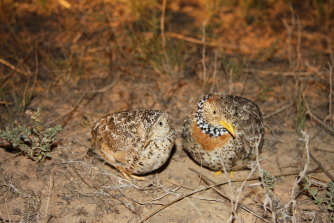
And plains wanderers were found at 85 per cent of the sites visited – the highest percentage of sites since surveys began.
“We were really excited to see so many chicks,” says Nugent. “There are probably only a handful of people in the world who have seen baby plains wanderers, so it’s a pretty nice feeling to know they were breeding.”
Adult birds are the size of a clenched fist, while the chicks are like a striped, fluffy golf ball. Male birds do the bulk of egg incubation and chick rearing.

PhD researcher Dan Nugent holds a plains wanderer during a survey.
High rainfall in Victoria due to the recent La Nina weather pattern caused a surge in native grass growth and generated increased insect and other invertebrate activity. In response the plains wanderers, which can have multiple clutches of chicks, have been “breeding around the clock”, says Nugent.
Land managers at the survey site – Terrick Terrick National Park, west of Echuca – have also become more experienced at managing vegetation to make it suitable. Plains wanderers don’t like it too dense, or too sparse, and so sheep and cattle are used to graze the grasslands to the right density.
The survey was undertaken by La Trobe in partnership with North Central Catchment Management Authority, as part of a report for the Department of Environment Land and Water and Planning.
Laura Chant, a project manager at the catchment authority, said technology and survey methods had improved. “Also, it’s highly likely the habitat management and protection measures ... over many years to protect this incredible bird are proving to be highly effective – including conservation covenants and strategic grazing of conservation reserves.”

Two plains wanderers caught in a spotlight.
After widespread flooding in 2010-11, the number of plains wanderers in Victoria dropped very low and there were estimated to be less than a couple of hundred birds in Victoria. They are now believed to number in the thousands.
Their biggest threat is the destruction of their native grassland habitat to turn it into pasture.
“If we can put a halt to the loss of native grasslands the future for the plains wanderer looks really bright,” says Nugent. “They have so little habitat left we can’t afford to lose any more.”
A guide to the environment, what’s happening to it, what’s being done about it and what it means for the future. Sign up to our fortnightly Clear Air newsletter here.









 Add Category
Add Category